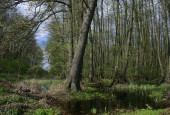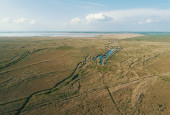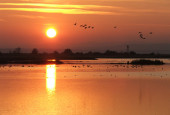Legends of Fertő (Neusiedl) landscape
Lake Neusiedl is the westernmost steppe lake in Europe, but its history and legends also make it unique in Hungary and Central Europe.
„The Fertő area hides its secrets from the untrained visitor, it only shows itself who is prepared. Those who know the story of the birth of Ladies’ Valley and Fertő, those who know why this landscape is unique and universal at the same time and are willing to take their time and attention to discover the tiny miracles of life.
Those who understand the deeper, spiritual meaning of the landscape, the palaces, the small village churches, the stone crosses, and the pietàs.”
Lake Neusiedl has always been surrounded by a kind of mystery. Due to water level fluctuations, it would sometimes flood villages, but it also dried up completely. Locals observed periods of 7 years for water level fluctuations and a 120-year-period for the lake to dry out.
There are a number of theories of how the lake was born. Some believed it was an ancient branch of the Danube, while the origin of other legends dates back to the 13th century; and local pretty girls are also said to have played an important role in its origins.
“Where the Lake Fertő is today, there used to be a deep valley in the past. There were lots of beautiful ladies living in the valley, so the valley was called accordingly: Ladies’ Valley. Fraknó’s lord liked hunting in this valley. Once, however, darkness fell over the land around noon and a violent storm broke out. The lord of the castle managed to find a shelter in a hut, where a widow lived with her daughter. The lord fancied the worthy and modest girl. From then on he always visited her when he was hunting in the area. But he had a wicked wife who didn’t like that her husband was visiting the poor widow and her daughter. She captured the girl and said: witch. The poor girl was sentenced to death and thrown into the nearby lake. Then the water of the lake began to rise, it was just rising and rising on, and quickly flooded the land, the forests and villages all around. The heartless chatelaine also died in the flood. Only a few people managed to escape into the mountains. The refugees later returned from the mountains and settled on the shore of the lake. They fonded Nezsider (Neusiedl am See).
The above legend explains the German name of the lake (Neusiedlersee), which it got from the new settlers. They arrived in the 16th century, and they were German-speaking free peasants (hospeses) migrating eastwards from Western Europe, and finally settling here.
According to our current knowledge, the formation of the lake happened approximately 20.000 years ago in the Ice Age, due to the sinking of the area along fault lines. The water level of the lake is most affected by rainfall and evaporation, and less by the watercourses flowing into the lake. Its average water level is between 120-150 cm.
Hanság was an integral part of Lake Neusiedl, as a swampy, marshy area dotted with smaller lakes. As the area was also connected to the water system of the Danube via the Rábca river, the Hanság also became flooded during the high water of the Danube. Fluctuations in the water level made it difficult to settle in the area, so first in the Roman era and then in the Árpádian era, attempts were made to drain certain parts of the region, to irrigate the land used for farming and to feed the fishponds with water. The medieval canal network of the Hanság has completely disappeared after the end of the Middle Ages and nature has once again taken control of the area.
The mystery of the marshland was reinforced by the will-o'-the-wisp, or the ghost lights, which is a light phenomenon accompanying the oxidation of phosphorus hydrogen released from the plants’ organic matter decomposing in the swamps. The alpine forests, with their characteristic above-the-ground air roots, were also characteristic plant communities of the marshland. In the middle of the 18th century, István Hany was found sitting on such an air root in the alder forest of Király Lake near Kapuvár.




